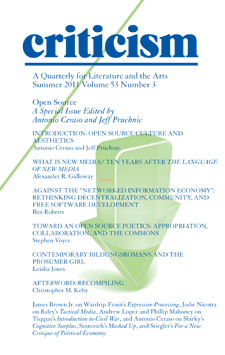Volume 53, Issue 3 (2011) Open Source
Introduction: Open Source Culture and Aesthetics
Like many phenomena that emerged parallel to that "place" we call the Internet, open source production has long been described via metaphors of spatiality, location, and presence. This trend likely started with programmer and open source software advocate Eric S. Raymond's early influential essays "The Cathedral and the Bazaar" (1997) and "Homesteading the Noosphere" (1999), both of which compare open source projects to a variety of public and private spaces, ecosystems, and architectural forms. In the late 1990s and through the last decade, as discussion of the politics of open source production has shifted more explicitly toward questions of copyright, appropriation, and intellectual property, open source proponents have increasingly invoked "the commons" - noncommodified public spaces and land areas - as conceptual reference points for rethinking intellectual property rights via the long and depressing history of the privatization of such resources. Without glossing over too many internal variations within these analogies, we might state that their connecting thread has most often been an emphasis on the relative novelty of open source projects, their scarcity among trends toward the increasing commodification of materials and services, and their general distinction from and counterposition to the traditional practices of capitalist economies; in other words, if open source and subsequent practices of participatory culture and voluntary collaborative labor have long been thought of as locations, it is perhaps because of their hoped-for function as some "other place": a heterotopia or utopia that is surrounded on all sides by the much larger and more familiar terrain of the global market.
By contrast the contributors to this special issue on "Open Source Culture and Aesthetics" might be taken as both privileging a temporal rather than spatial approach to thematizing open source production as well as disputing its peripheral status; more specifically, they all craft their point of intervention in reference to questions of periodization, suggesting that a broad historical transformation is under way as the primary pragmatic principles of open source software communities - that production and distribution processes can be made both more efficient and effective by leveraging the labor, contributions, and feedback of large groups of users - increasingly seem central to, rather than a novelty within, contemporary economic and cultural production. This shift in perspective might be more properly taken as more than just an alternative framework for comparison. Rather, it marks a moment in which open source ceases to be understandable by way of comparisons to other phenomena and instead takes on its own explanatory value. And, indeed, open source as a term or concept has become its own analogical referent, one that links a vast field of practices moving far from its initial origins and intentions in software programming.
Read more...Preface
Introduction: Open Source Culture and Aesthetics
Antonio Ceraso and Jeff Pruchnic
Articles
What Is New Media? Ten Years after The Language of New Media
Alexander R. Galloway
Book Reviews
Open Process Software
James J. Brown Jr.
The Irritants of Empire: Rita Raley's Tactical Media
Jodie Nicotra
Know the Enemy
Andrew Lopez and Phillip Mahoney
Postscript on Contribution Societies
Antonio Ceraso
Afterword
Afterword::Recompiling
Christopher M. Kelty

Open Source
- Guest Editor
- Antonio Ceraso and Jeff Pruchnic
